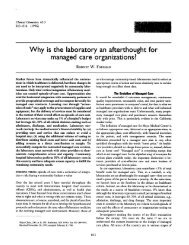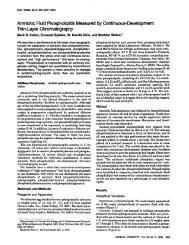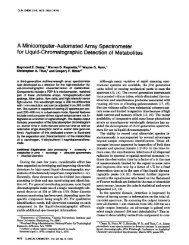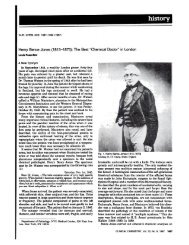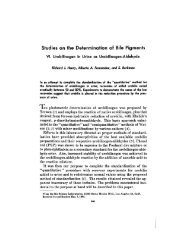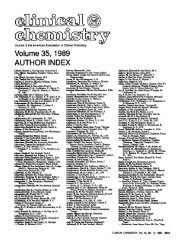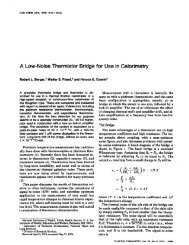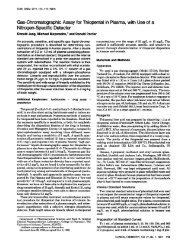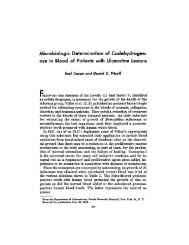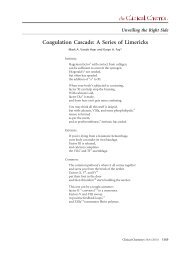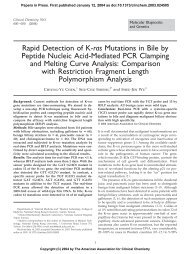Daylily S. Ooi Div. of Biochem. Dept. of Lab ... - Clinical Chemistry
Daylily S. Ooi Div. of Biochem. Dept. of Lab ... - Clinical Chemistry
Daylily S. Ooi Div. of Biochem. Dept. of Lab ... - Clinical Chemistry
You also want an ePaper? Increase the reach of your titles
YUMPU automatically turns print PDFs into web optimized ePapers that Google loves.
696 Letters<br />
2. Asplin JR, Favus MJ, Coe FL. Nephrolithiasis.<br />
In: Brenner BM, ed. Brenner & Rector’s The<br />
kidney, 5th ed. Philadelphia: WB Saunders,<br />
1996:1893–935.<br />
3. Smith LH. The medical aspects <strong>of</strong> urolithiasis:<br />
an overview. J Urol 1989;141:707–10.<br />
4. Mandel NS, Mandel GS. Urinary tract stone<br />
disease in the United States veteran population.<br />
II. Geographical analysis <strong>of</strong> variations in<br />
composition. J Urol 1989;142:1516–21.<br />
5. Coe FL, Parks JH. New insights into the pathophysiology<br />
and treatment <strong>of</strong> nephrolithiasis:<br />
new research venues. J Bone Miner Res 1997;<br />
12:522–33.<br />
6. Ruml LA, Pearle MS, Pak CYC. Medical therapy.<br />
Calcium oxalate urolithiasis. Urol Clin North Am<br />
1997;24:117–33.<br />
7. Low RK, Stoller ML. Uric acid-related nephrolithiasis.<br />
Urol Clin North Am 1997;24:135–48.<br />
<strong>Daylily</strong> S. <strong>Ooi</strong><br />
<strong>Div</strong>. <strong>of</strong> <strong>Biochem</strong>.<br />
<strong>Dept</strong>. <strong>of</strong> <strong>Lab</strong>. Med.<br />
and Bone and Renal Stone Clin.<br />
Ottawa Civic Hosp.<br />
1053 Carling Ave.<br />
Ottawa, ON K1Y 4E9, Canada<br />
and <strong>Dept</strong>. <strong>of</strong> Pathol. and Med. <strong>Lab</strong>.<br />
University <strong>of</strong> Ottawa<br />
E-mail dsooi@civich.ottawa.on.ca<br />
A spokesperson from Merck responds:<br />
To the Editor:<br />
We have not claimed that our semiquantitative<br />
analysis is comparable<br />
with a high-sensitivity infrared spectroscopic<br />
analysis. Nevertheless,<br />
Merck will evaluate the determination<br />
<strong>of</strong> oxalate to check whether it is necessary<br />
to modify the oxalate color scale<br />
to prevent erroneous interpretations<br />
(background). Blanking with water is<br />
absolutely not allowed because all reactions<br />
work correctly only under acid<br />
conditions; the urate calculi must be<br />
dissolved in concentrated sulfuric acid<br />
and water, and all tests are optimized<br />
for these conditions.<br />
Ludwig Jakobi<br />
Merck KGaA<br />
Darmstadt, Germany<br />
Cross-Reactivity <strong>of</strong> Fosphenytoin in<br />
Four Phenytoin Immunoassays<br />
To the Editor:<br />
Fosphenytoin, 5,5-diphenyl-3-[(phosphonooxy)methyl]-2,4-imidazolidinedione<br />
disodium salt (Cerebyx ® ; Parke-<br />
Davis), is a phosphorylated form <strong>of</strong> the<br />
anticonvulsant drug phenytoin. Fosphenytoin<br />
itself has no pharmacological<br />
activity but is dephosphorylated in<br />
vivo by phosphorylases to the active<br />
drug, phenytoin. The elimination halflife<br />
<strong>of</strong> fosphenytoin in plasma is 8–15<br />
min in healthy subjects [1, 2]. Fosphenytoin<br />
can be used for parenteral or<br />
intramuscular administration, where<br />
its superior aqueous solubility results<br />
in less severe side effects than does<br />
phenytoin [2, 3]. Few data, however,<br />
are available on the interference <strong>of</strong><br />
fosphenytoin in phenytoin immunoassays,<br />
which are currently the most<br />
common method used to monitor patients’<br />
phenytoin concentrations. In an<br />
abstract [4], Kugler et al. reported that<br />
the TDx ® Phenytoin assay (Abbott<br />
<strong>Lab</strong>s.) was interfered with by fosphenytoin.<br />
We report here the results <strong>of</strong><br />
detailed cross-reactivity studies for<br />
fosphenytoin in four phenytoin immunoassays:<br />
ACS:180 ® Automated<br />
Chemiluminescence System (Chiron<br />
Diagnostics), TDx Phenytoin and Phenytoin<br />
II, and AxSym ® Phenytoin II<br />
(also from Abbott <strong>Lab</strong>s.).<br />
A therapeutic total plasma phenytoin<br />
concentration (10 mg/L) is<br />
attained within 10–30 min after administration<br />
<strong>of</strong> fosphenytoin. Conversion<br />
<strong>of</strong> fosphenytoin to phenytoin<br />
is reported to be complete in 2–4 h,<br />
depending on mode and rate <strong>of</strong> administration<br />
[5]. The plasma concentration<br />
<strong>of</strong> fosphenytoin depends on<br />
the route <strong>of</strong> administration and<br />
length <strong>of</strong> time between administration<br />
and patient sampling. The ordinary<br />
half-life <strong>of</strong> fosphenytoin is reduced<br />
by 50% in patients with<br />
hepatic or renal diseases, apparently<br />
because <strong>of</strong> less protein binding <strong>of</strong> the<br />
prodrug [5].<br />
A stock solution <strong>of</strong> fosphenytoin (a<br />
gift from Parke-Davis) in methanol<br />
was added to two separate serum<br />
pools—one without phenytoin (pool<br />
A), and the other containing 12.4<br />
mg/L <strong>of</strong> phenytoin (pool B)—to give<br />
final fosphenytoin concentrations <strong>of</strong><br />
52, 39, 26, and 13 mg/L. Apparent<br />
phenytoin concentrations in both sets<br />
<strong>of</strong> samples were measured by all<br />
four assays according to the manufacturers’<br />
directions.<br />
The TDx and AxSym assays use<br />
homogeneous fluorescence polarization<br />
(FPIA) technology and were run<br />
on the TDxFlx ® and AxSym automated<br />
analyzers, respectively. The<br />
TDx Phenytoin (TDx) assay uses a<br />
polyclonal sheep anti-phenytoin antiserum,<br />
whereas the TDx Phenytoin<br />
II (TDx-II) and AxSym Phenytoin II<br />
(AxSym-II) assays use murine monoclonal<br />
antisera. The ACS:180 Phenytoin<br />
(ACS:180) is a heterogeneous<br />
chemiluminescent immunoassay that<br />
uses murine monoclonal antibody; it<br />
was run on the automated, randomaccess<br />
ACS:180 chemiluminescent<br />
system [6–8]. The analytical range<br />
(0.5–40 mg/L) and detection limit (1<br />
mg/L) for the TDx and ACS:180 assays<br />
are similar [8], but the AxSym-II<br />
assay has a lower detection limit (0.5<br />
mg/L). Results <strong>of</strong> the ACS:180 assay<br />
agree well with both TDx and TDx-II<br />
assays [7, 8], whereas the AxSym-II<br />
assay correlates with the TDx-II assay<br />
(AxSym-II package insert).<br />
The results for fosphenytoin crossreactivity<br />
in pool A for the four phenytoin<br />
assays (Table 1) show that the<br />
TDx-II cross-reacted very strongly<br />
(250%) with fosphenytoin; such<br />
cross-reactivity would result in seriously<br />
high TDx-II assay results, even<br />
in samples containing very low concentrations<br />
(5 mg/L) <strong>of</strong> fosphenytoin.<br />
Fosphenytoin cross-reactivity in<br />
the absence <strong>of</strong> phenytoin for the<br />
other three assays exhibited the following<br />
order: ACS:180 TDx <br />
TDx-II AxSym-II. However, although<br />
the ACS:180 cross-reactivity<br />
was independent <strong>of</strong> fosphenytoin<br />
concentration, that <strong>of</strong> TDx and Ax-<br />
Sym-II decreased with increasing<br />
concentrations <strong>of</strong> fosphenytoin.<br />
Table 1 also presents our data on<br />
the interference <strong>of</strong> fosphenytoin in<br />
the four assays in serum pool B,<br />
containing 12.4 mg/L phenytoin.<br />
The fosphenytoin cross-reactivity in<br />
TDx and AxSym-II assays was 2-<br />
and 3-fold greater, respectively, in<br />
the presence <strong>of</strong> phenytoin than in its<br />
absence. Given that the rate <strong>of</strong> fosphenytoin<br />
metabolism may differ<br />
from person to person or in different<br />
disease states, the higher cross-reactivity<br />
in presence <strong>of</strong> phenytoin is <strong>of</strong><br />
concern. Cross-reactivity in the ACS:<br />
180 assay, however, was indepen-
<strong>Clinical</strong> <strong>Chemistry</strong> 44, No. 3, 1998 697<br />
Table 1. Cross-reactivity <strong>of</strong> fosphenytoin in TDx Phenytoin, TDx Phenytoin II, AxSym Phenytoin II, and ACS:180 Phenytoin<br />
assays in serum pools A (no phenytoin) and B (containing phenytoin).<br />
Phenytoin equivalent, mg/L (and cross-reactivity a,b ,%)<br />
TDx TDx-II AxSym-II ACS:180<br />
Fosphenytoin<br />
concn., mg/L<br />
A B A B A B A B<br />
0.0 ND 12.4 ND 12.5 ND 12.1 ND 12.4<br />
13.0 5.5 (42) 22.2 (75) 33.0 (254) 3.8 (29) 22.2 (78) 6.5 (50) 19.0 (51)<br />
20.0 7.5 (38) 26.6 (71) 4.8 (24) 26.8 (74) 9.8 (49) 22.4 (50)<br />
26.0 9.2 (35) 30.1 (68) 5.3 (20) 28.5 (63) 12.5 (48) 25.6 (51)<br />
39.0 13.0 (33) 35.4 (59) NA NA 20.0 (51) 32.0 (50)<br />
52.0 16.4 (32) 6.7 (17) 27.6 (30) 27.3 (52) <br />
a Cross-reactivity (%) in absence <strong>of</strong> phenytoin (pool A) 100 (apparent phenytoin concentration observed)/(fosphenytoin concentration in sample).<br />
b Cross-reactivity (%) in presence <strong>of</strong> phenytoin (pool B) 100 [(apparent phenytoin concentration observed in presence <strong>of</strong> fosphenytoin) (phenytoin<br />
concentration in absence <strong>of</strong> fosphenytoin)]/(fosphenytoin concentration in sample).<br />
ND, not detected; , greater than the range <strong>of</strong> the assay (40 mg/L); NA, not available.<br />
dent <strong>of</strong> the presence <strong>of</strong> phenytoin.<br />
Similar data have also been found in<br />
interference studies <strong>of</strong> oxaprozin in<br />
the TDx-II assay, in which cross-reactivity<br />
to oxaprozin increased by 5%<br />
in the presence <strong>of</strong> 10 mg/L phenytoin<br />
[9].<br />
In summary, different phenytoin<br />
immunoassays may cross-react differently<br />
with fosphenytoin, resulting<br />
in discordant results for samples containing<br />
fosphenytoin. Because <strong>of</strong> this<br />
problem, serum specimens taken<br />
from patients treated with fosphenytoin<br />
before all <strong>of</strong> the prodrug is metabolized<br />
(2–4 h after the drug administration<br />
is complete) may yield<br />
misleading phenytoin immunoassay<br />
results. Finally, whereas the ACS:180<br />
assay shows consistent cross-reactivity<br />
to fosphenytoin in samples with<br />
or without phenytoin, the TDx assay<br />
cross-reactivity is dependent on both<br />
fosphenytoin and phenytoin concentrations.<br />
This underlines the importance<br />
<strong>of</strong> cross-reactivity determination<br />
in both the presence and the<br />
absence <strong>of</strong> the primary analyte.<br />
References<br />
1. Bebin M, Bleck T. New anticonvulsant drugs<br />
[Review]. Drugs 1994;48:153–71.<br />
2. Browne TR, Kugler AR, Eldon MA. Pharmacology<br />
and pharmacokinetics <strong>of</strong> fosphenytoin. Neurology<br />
1996;46(Suppl 1):S3–7.<br />
3. Mattson RH. Parenteral antiepileptic/anticonvulsant<br />
drugs. Neurology 1996;46(Suppl 1):<br />
S8–13.<br />
4. Kugler AR, Olsen SC, Webb CL, Annesley T,<br />
Nordblom GD, Koup JR. Cross-reactivity <strong>of</strong> fosphenytoin<br />
(Cerebyx ® ) in 2 human phenytoin<br />
immunoassays [Abstract]. Pharmacol Res<br />
1994;11(Suppl):S102.<br />
5. Aweeka F, Alldredge B, Boyer T, Warnock D,<br />
Gambertoglio J. Conversion <strong>of</strong> ACC-9653 to<br />
phenytoin in patients with renal or hepatic<br />
diseases. Clin Pharmacol Ther 1988;43:178.<br />
6. Datta P, McLaughlin L, Walsh R, Alpert A,<br />
Morehouse S. An automated chemiluminescent<br />
phenytoin assay in a heterologous format<br />
[Abstract]. Clin Chem 1996;42:S213.<br />
7. Datta P, McLaughlin L, Walsh R, Alpert A,<br />
Morehouse S, Kwiatek K. Comparison <strong>of</strong> three<br />
automated phenytoin assays <strong>of</strong> different specificity<br />
[Abstract]. Clin Chem 1996;42:S213.<br />
8. Dasgupta A, Datta P, Redlich G, Limmany A.<br />
Analytical performance <strong>of</strong> a new chemiluminescent<br />
phenytoin (ACS:180) assay. Ther Drug<br />
Monit 1997;19:191–4.<br />
9. Datta P. Oxaprozin and 5-(p-hydroxyphenyl)-5-<br />
phenylhydantoin interference in phenytoin immunoassays<br />
[Letter]. Clin Chem 1997;43:<br />
1468–9.<br />
Pradip Datta*<br />
Chiron Diagnostics<br />
E. Walpole, MA 02032<br />
Amitava Dasgupta<br />
<strong>Dept</strong>. <strong>of</strong> Pathol.<br />
Univ. <strong>of</strong> New Mexico<br />
Albuquerque, NM 87106<br />
*Author for correspondence. Fax 508-<br />
660-4591; e-mail pradip.datta@chirondiag.<br />
com.




